Bologna is one of the most renowned and fascinating cities in northern Italy.
Its university (Alma Mater Studiorum) is the oldest in the Western world and has given it the nickname 'learned'. Its rich and tasty cuisine can be felt in the streets of the centre and has given it the nickname 'grassa' (fat). The red colour of its historic buildings creates a striking atmosphere and has given it the nickname 'red'!
Its historical centre with its medieval arcades, squares, ancient buildings, two towers and the friendly welcome of the Bolognese people will give you an experience full of culture and fun. In this article, we propose a walking itinerary that will introduce you to the historical and symbolic places of the city in one day. Let's find out what to do and see in one day in Bologna.
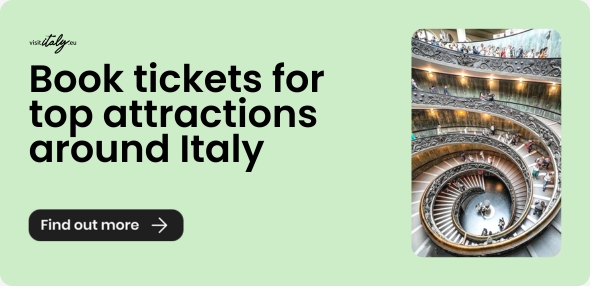
What to do and see in Bologna in a day
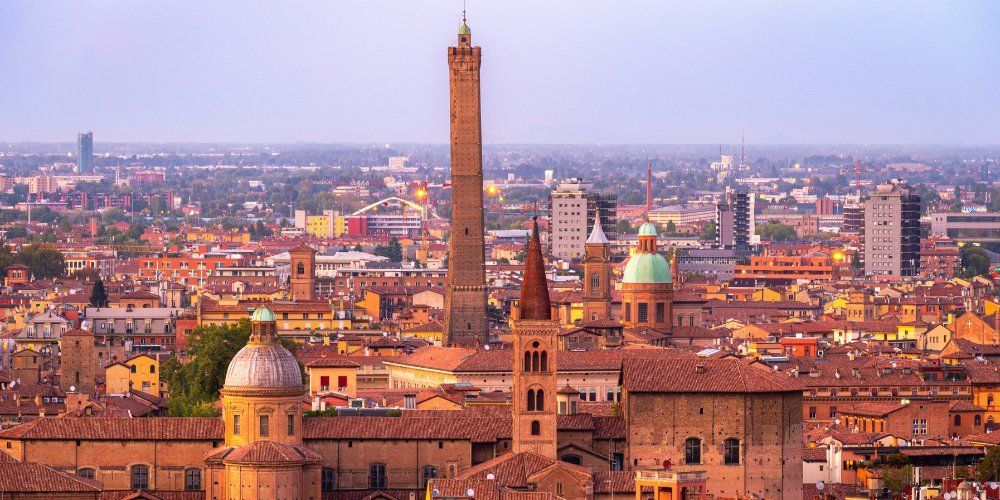
Bologna: a view of the city centre - ph. credits: Petr Slovacek - unsplash
Bologna's most important historical and cultural attractions are in the historic centre. For this reason, it's easy and convenient to visit the city on foot.
Walking around Bologna will be fine even on rainy days thanks to the many porticos (more than 40 km), which, together with the towers and tortellini, are symbols of the city. From 2021, they are included in the UNESCO World Heritage list.
Come rain or shine, you can always walk around the city in the shade of its porticos!
Bologna is strategically located and enjoys excellent rail, air and motorway connections with the north and south-central parts of the country. If you arrive by train, once at the station, you can reach the historic centre with a 15-minute walk.
Near the railway station are several multi-storey car parks, where you can leave your car and walk around the city.
If you arrive in Bologna by plane, from the airport, you can reach the railway station by bus in less than half an hour, or by train with the 'Marconi express', in less than 10 minutes.
Your itinerary on foot to discover Bologna starts right from the train station: Piazza Maggiore, the Neptune fountain, the towers, the medieval arcades, San Luca, the trattorias and much more...let's discover what to do and see in one day in Bologna!
Book a guided walking tour of the historic centre9 am: Stroll along via Indipendenza and stop at the Montagnola
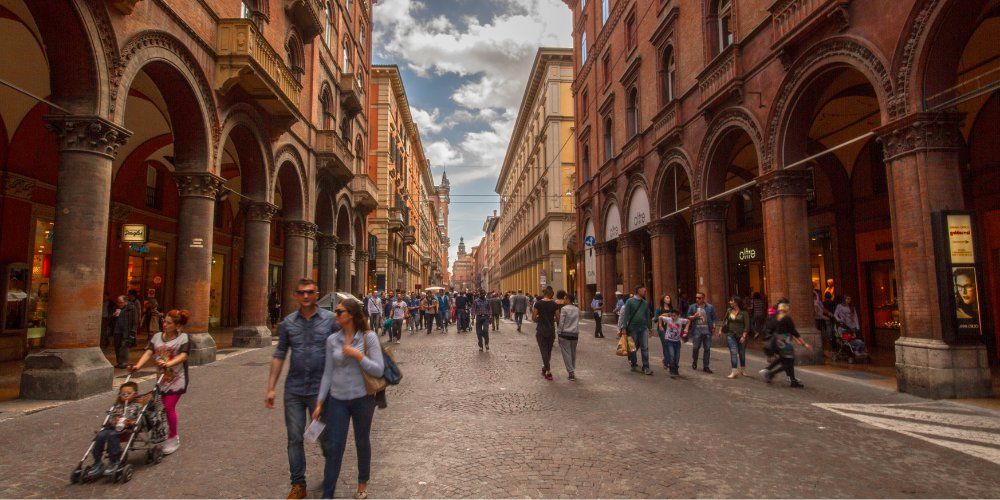
Bologna: via Indipendenza - Ph. credit: Wildlab, Bologna Welcome
From the station, the easiest and most convenient way to reach the historic centre is to walk along Indipendenza Street, a straight stretch of about 1 km where history and modernity meet.
Here you will find Bologna's first porticoes and strolling among modern and historical shop windows, you will also encounter several valuable cultural attractions such as St Peter's Cathedral, a Gothic-style church whose interior houses precious works of art such as the altarpiece by Giovanni da Modena.
Continuing, you will arrive at the picturesque Piazza VIII Agosto, dominated by the Vittorio Emanuele II monument and surrounded by beautiful buildings and outdoor cafés, where it is nice and relaxing to sip a good coffee.
You will also pass by the Arena del Sole, one of the most important theatres in Italy, and admire its neoclassical façade and the statues on the roof. Arriving at the end of Via Indipendenza, you will find yourself in Piazza Nettuno, the heart of the historical centre!
From Via Indipendenza, a monumental flight of steps also leads to Montagnola Park, a green oasis of peace in the city centre.
The tree-lined avenues, flower beds and pond create an atmosphere of harmony and tranquillity.
In the shade of centuries-old trees, one can relax by reading a book, strolling or sipping a drink at the kiosk.
This park, especially in fine weather, becomes a natural stage for events and concerts, and every Friday and Saturday, one of the most unique weekly markets in Italy, also declared Historical Market of Emilia Romagna, is held here.
Strolling along via Indipendenza, you can make a stop at the Montagnola. From the top of the park, you can enjoy an impressive panoramic view of Bologna with its towers, roofs, squares and bell towers!
10 am: Piazza Nettuno and Piazza Maggiore
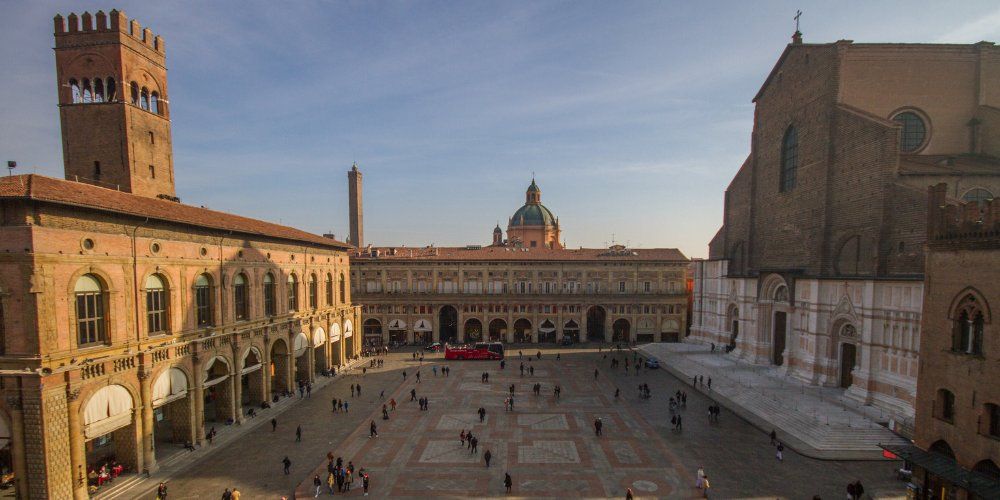
Piazza Maggiore - Bologna - Ph. Credit: Wildlab, Bologna Welcome
You are in Piazza Nettuno with the famous Neptune fountain in front of you!
Piazza del Nettuno was designed in 1564 to highlight the fountain with its bronze statue of Neptune, surrounded by dolphins, putti, sirens and heraldic coats of arms.
The statue, criticised in the past for the nudity of Neptune and the female figures, is now a meeting point for the people of Bologna.
On either side of the square are elegant historical buildings such as Palazzo del Podestà, Palazzo Re Enzo and Sala Borsa, since 2001 the Biblioteca Civica Multimediale.
Inside the Biblioteca Civica Multimediale (Multimedia Civic Library), you can not only view books free of charge but, thanks to the excavations inside, you can also see Roman remains and seven centuries of Bologna's history.
Adjacent to Piazza Nettuno, the famous Piazza Maggiore, also known as Piazza Grande. You will immediately notice the Basilica di San Petronio and its unfinished pink and white marble façade.
In this imposing church, one of the largest in Europe, you will admire fine frescoes from the 15th century and works by illustrious painters, including Parmigianino. It is also home to the tomb of Elisa Bonaparte, Napoleon's sister.
The square is framed by the Gothic Palazzo d'Accursio, the Renaissance Palazzo dei Notai, the seat of the ancient guild of notaries, and the scenic façade of Palazzo dei Banchi with its historic shops.
Palazzo D'Accursio, with its Clock Tower, was the home of the d'Accursio family and seat of the papacy.
Today, it is the seat of the municipality. It also houses the Morandi Museum with the works of the Bolognese painter Giorgio Morandi and the Collezioni Comunali d'Arte Antica (Municipal Collections of Ancient Art), which include works from the 13th to the early 20th century.
Visit Palazzo D'Accursio with the Clock Tower and the Municipal Art Collections11:30 am. : What to see in Bologna in one day: the Basilica of San Luca

Basilica di san Luca - Bologna - Ph. Credit: Constantin Mutaf - unsplash
After visiting the two most important squares in the historical centre, it is time for another unmissable stop in Bologna: the Basilica of San Luca.
This sanctuary, linked to the cult of the image of the Madonna kept inside, stands on Colle della Guardia and is another symbol of Bologna.
The sanctuary is connected to the city centre by a portico of about 4 km. With more than 600 arches, this is the longest portico in the world.
From the Colle, there is also a stunning view of the city and the surrounding landscape.
Those who love walking can reach the Basilica of San Luca on foot. From Piazza Maggiore, walk along Via Saragozza to the Arco del Meloncello, where the long portico of San Luca starts.
A less strenuous and more comfortable alternative to make the most of your time is the San Luca Express tourist train, which will take you from Piazza Maggiore to the sanctuary.
The journey on the San Luca Express is fun and fascinating. Along the way, you will hear the history of the sanctuary, and you will see the streets of the historic centre with its porticoes, traditional shops and trattorias!
Once you arrive at the Colle, after visiting the Sanctuary, you can relax, enjoy the view over the hills of Bologna, and even have a drink in one of the bars near the Sanctuary.
Book the San Luca Express1 pm: Lunch at Mercato delle Erbe or Mercato di Mezzo

Tortelloni - lunch in Bologna - Ph. Credit: Wildlab, Bologna Welcome
After San Luca, you can head back towards the centre and stop at one of Bologna's historic markets for a good lunch and rest before resuming your itinerary to discover the other cultural attractions of Bologna's historic centre.
The Mercato delle Erbe has an ancient history. It was designed in 1910, renovated and reopened to the public in 1949 after heavy bombing during World War II.
It is accessed from the central Via Ugo Bassi. You will find traditional fruit and vegetable stalls, restaurants and wine bars.
Here, in a warm environment in winter and cool in summer, you can eat and drink in one of the many restaurants in a simple, informal and cosy atmosphere.
You can also buy some 'gastronomic souvenirs' to take home!
The other ancient and historical market in Bologna is the Mercato di Mezzo, located a few metres from Piazza Maggiore.
Since the Middle Ages, this market has been a place of meetings, trade and traditional flavours!
Today at the Mercato di Mezzo, you can buy food and wine products, eat traditional Bolognese dishes and enjoy excellent wine tastings!
2:30 pm: Piazza Galvani, the Archiginnasio and Via D'Azeglio
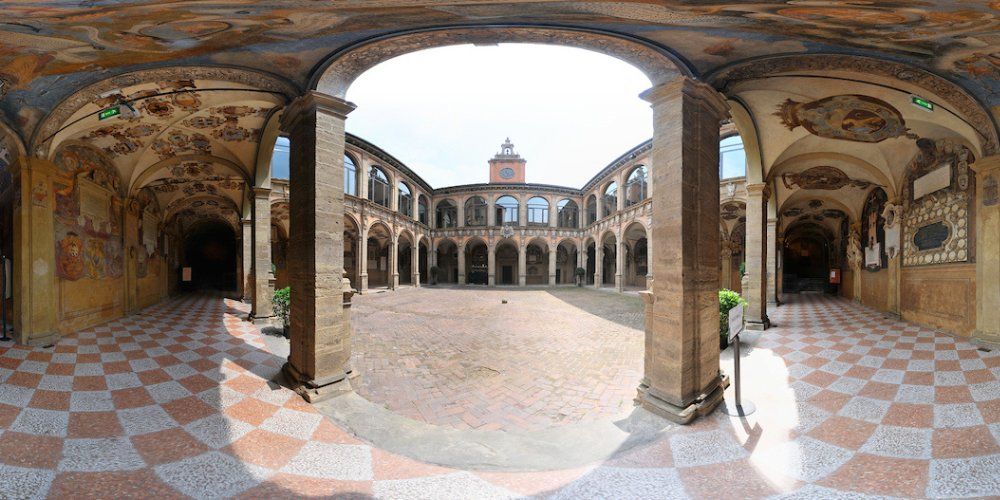
The Archiginnasio - Bologna - Ph. Credit: Bologna Welcome
After your lunch break, head to Piazza Galvani, where you will find the Archiginnasio, one of Bologna's most important historical buildings.
Before reaching the square, however, make a diversion to D'Azeglio Street.
On this street, you will notice elegant shops, cafés and fine buildings such as the beautiful Renaissance palace Palazzo Sanuti Bevilacqua Degli Ariosti, where three sessions of the Council of Trent were held in 1547.
But this street is also linked to the celebrated Bolognese singer-songwriter Lucio Dalla, who passed away in 2012.
Lucio lived in a house overlooking Via D'Azeglio. He used to stroll through the streets and squares of Bologna's historic centre.
Today, on the façade of the singer-songwriter's house in Via D'Azeglio, we find the image of the artist while playing his saxophone.
On various occasions of the year, illuminations created with the lyrics of the beloved singer-songwriter are displayed in the street.
The Archiginnasio Palace was the first historical seat of the University of Bologna, the Alma Mater Studiorum.
Built by architect Antonio Morandi, with its central courtyard and long portico of 30 arches, it still retains the typical appearance of an ancient university.
Since 1838, the Archiginnasio has been home to the Municipal Library and is a place of art and science.
Inside, of great notice, is the Teatro Anatomico (Anatomical Theatre), a wooden amphitheatre-shaped room formerly used for anatomy lessons.
Various statues of famous anatomists and doctors can be seen in this room, as well as decorations of symbolic figures representing the constellations and the god Apollo, protector of medicine.
Inside the palace, you can also visit 2 big rooms: one for the Artists, now the Reading Room of the Library, and one for the Legists, called the Stabat Matern Hall.
The Stabat Matern Hall, with its remarkable decorations, is one of the most representative rooms of the former university.
Visit the Archiginnasio3:30 pm: Piazza Santo Stefano and the Two Towers
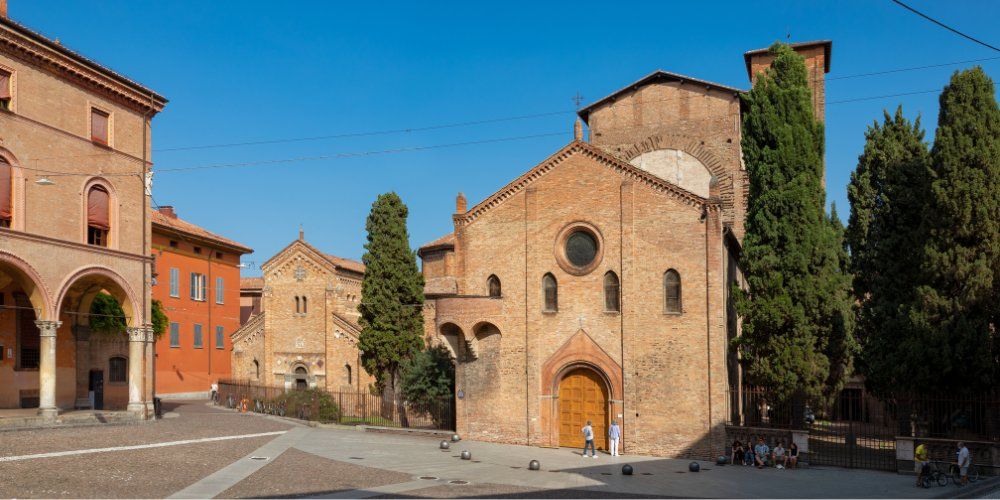
Piazza Santo Stefano - Bologna - Ph. Credit: M.A. Ghilardi, Bologna Welcome
Another place to see in Bologna is Piazza Santo Stefano.
The square is a widening that leads to the two Towers.
It's dominated by the Basilica di Santo Stefano, also known as the 'seven churches' complex.
In fact, the Basilica consists of seven sacred buildings built in different eras. Inside the complex, in addition to the seven churches, you can admire the Cortile di Pilato and the beautiful medieval cloister.
A visit to the St Stephen's complex will not leave you disappointed!
In addition to the Basilica, the square is surrounded by the arcades of fine buildings such as Casa Berti, Palazzo Isolani, the 15th-century Palazzo Bolognini Isolani and the 16th-century Palazzo Bolognini Amorini Salina.
This square is one of the most evocative places in Bologna.
It is a meeting place for the Bolognese and is often used for cultural and musical events.
The next stop will be at another symbol of Bologna: the two Towers.
There are more than twenty medieval towers in Bologna!
Located right in the historical centre, the Torre degli Asinelli and the Torre Garisenda are the two most famous leaning medieval towers in Bologna.
The Asinelli Tower was built by the Asinelli family in the 12th century. It measures 97.2 metres and is the highest-leaning medieval tower in Italy.
Unless closed for maintenance, this tower is the only one that can be visited. Inside, a staircase with 498 steps allows us to climb to the top and admire a splendid panorama of the city.
The Garisenda Tower, built in the same period, is half the size of the Asinelli Tower and has a greater inclination.
In fact, due to its steep slope, it was also cut down in the 14th century for fear of possible collapse.
5:30 pm: The Jewish Ghetto and Little Venice
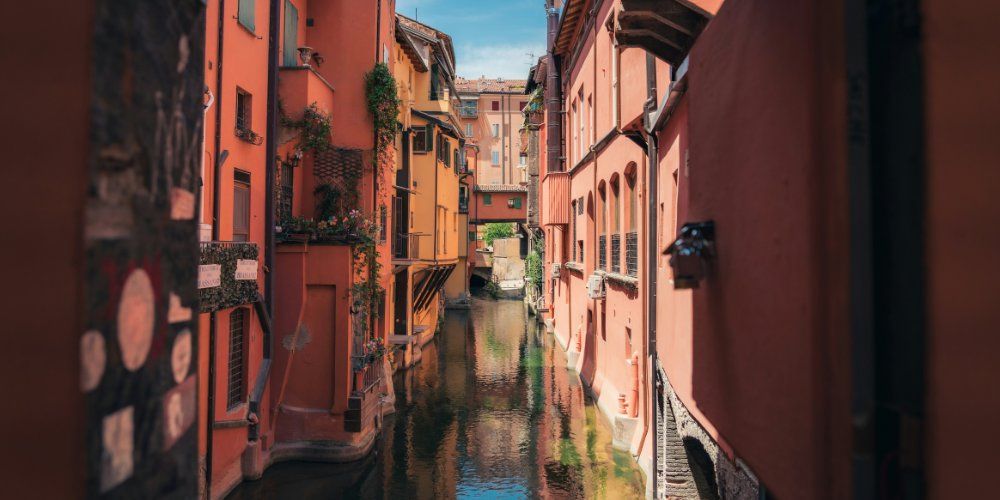
The little Venice - Bologna - Ph. Credit: Daniel Sessler - Unsplash
From the Two Towers, you can explore what was once the old Jewish ghetto, one of the most fascinating and evocative areas in the historic centre.
A collection of narrow streets, small windows, palaces and old workshops where Jews lived from 1556.
The main street of the Ghetto is Via dell'Inferno, where other small streets like Via de' Giudei, Via Canonica, Vicolo Mandria and Via Valdonica converge.
On Via dell'Inferno, you will find the old Synagogue built in the mid-1800s.
This building, severely damaged during World War II, was restored and returned to the city in 1955. It is possible to visit the Synagogue by appointment.
In the ghetto, you will also find the Jewish Museum, a building of great cultural interest that disseminates and enhances the Jewish cultural heritage in Bologna and various places in Emilia Romagna.
Now get ready to experience an undiscovered Bologna!
Head towards Via Piella.
Along the street, you will find a small window.
Open it, and you will see a never-before-seen Bologna that will remind you of Venice!
From the small window of Via Piella, you will see colourful houses and small balconies overlooking the Moline Canal.
This ancient waterway passes through the historic centre of Bologna, creating a Venetian atmosphere!
Other suggestive glimpses of Bologna's little Venice can be seen from Via Oberdan and Via Capo di Lucca.
6.30 pm: An enjoyable aperitif in a bar in the historic centre
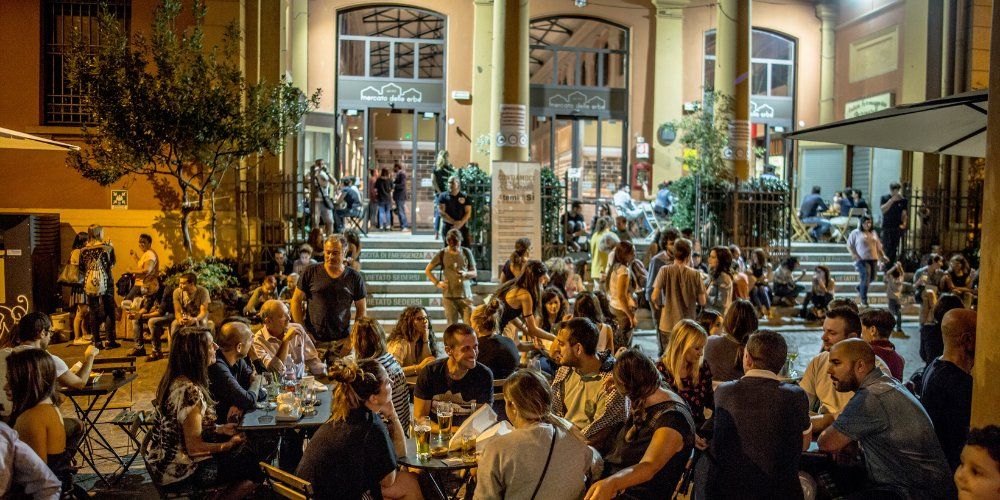
Aperitif in Bologna - Ph. Credit: Wildlab, Bologna Welcome
After the historical and cultural sights, it is time to immerse yourself in the flavours of excellent Bolognese cuisine.
To start, you can have an enjoyable aperitif with typical Bolognese products, cold cuts, cheese and wine in one of the many venues in the historic centre.
The historic markets such as Mercato delle Erbe and Mercato di Mezzo are suitable places for an aperitif or wine tasting in a lively and informal atmosphere.
Alternatively, there are bars and wine bars where excellent wines can be tasted.
A particularly characteristic place popular with the Bolognese is the Osteria del Sole, the oldest osteria in Bologna.
In this osteria, which dates back to 1465, only alcoholic drinks are served.
Anyone wishing to accompany drinks with something to eat must buy food in one of the surrounding shops.
Please note: at the Osteria del Sole, non-alcoholic beverages aren't available.
However, non-drinkers are welcome with their water or alternative drinks!
Take a guided wine tour in Bologna8 pm: Dinner in a trattoria
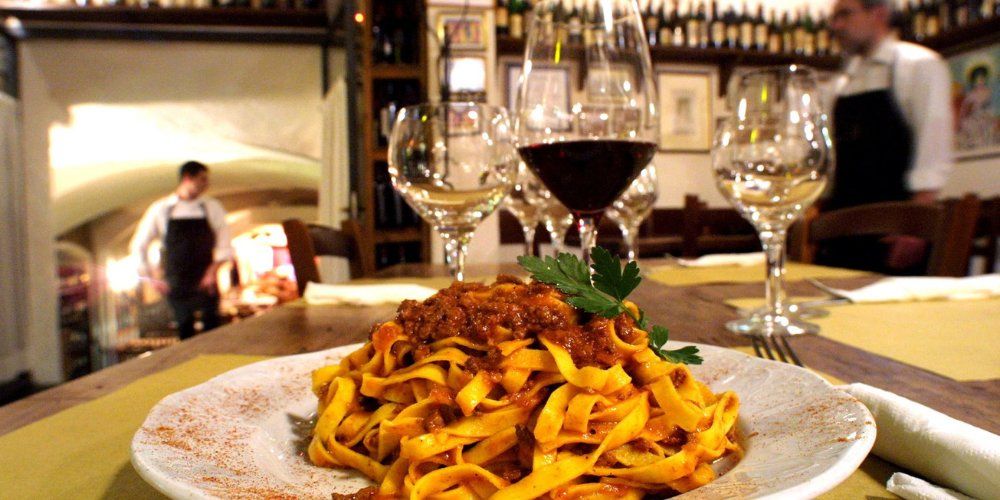
Dinner in a trattoria - Bologna - Ph. Credit: Meridiana Immagini, Bologna Welcome
How better to end your day in Bologna than with a good dinner in a trattoria in the historic centre?
Strolling through the streets of the centre in the evening light, let the Bolognese suggest a good trattoria where you can sample the typical dishes of tasty Bolognese home cooking: lasagne, tortelloni, tortellini, tagliatelle, salami, tigelle and much more.
Bolognese trattorie and osterie have always welcomed guests in a cosy and familiar atmosphere and ambience, offering tasty traditional dishes in generous portions and at reasonable prices.
Trattorias and osterias are institutions in Bologna, and anyone passing through, even for just one day, must go there.
After all, the flavours of Emilia are among the richest and tastiest in the country!
A day in Bologna: the alternatives
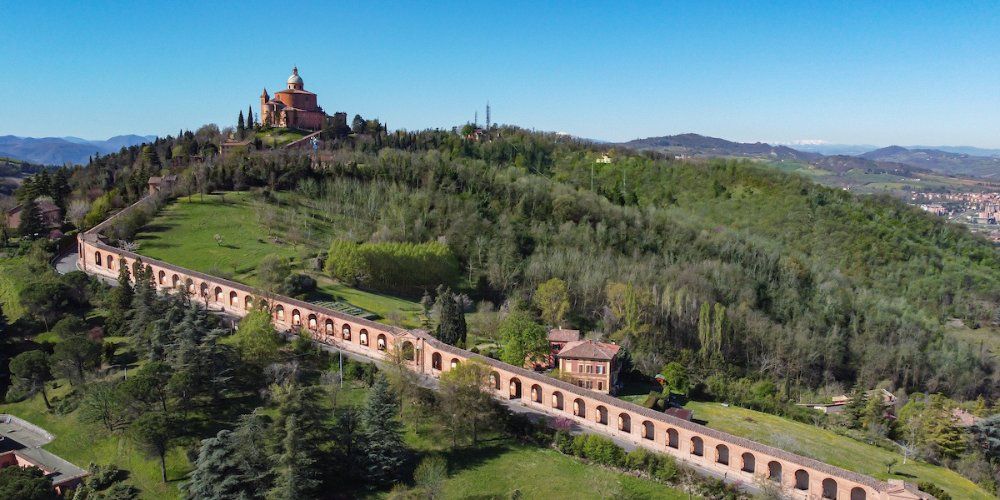
San Luca portico - Bologna - Ph. Credit: Wildlab Multimedia, Bologna Welcome
This walking itinerary takes you to Bologna's main attractions while optimising your time.
All these places are close to each other. Therefore, you can choose the order of the stages and spend more time on the sites that interest you most.
If you decide to go to the Sanctuary of San Luca on foot, consider that you will have to walk a total of about 12 km, so you will have to organise your time as best you can.
However, especially in fine weather when the days are longer, arriving early in Bologna will give you plenty of time to enjoy the walk to San Luca and to visit the city's other cultural attractions.
Lovers of singer-songwriter songs can take a walk among the places dear to Lucio Dalla, the songwriter who dedicated several verses of his most famous songs to his hometown.
Wandering just as Lucio loved to do, you can stop at the bench in Piazza Cavour, where you will find his statue!
You can pass by Via degli Orefici, known as Via del Jazz, where you will find a series of white and gold stars commemorating famous artists who played in Bologna.
And then on to the square and the Basilica of San Domenico and finally to the monumental cemetery where you will find Lucio's tomb engraved with a phrase from one of his most famous songs.
If you like parks and gardens, we recommend the park of Villa Spada, a fascinating park with statues and dense and varied vegetation, which can be reached from the city centre with a relaxing walk of just over 30 minutes.
On a day in Bologna, you can do and see a lot.
Choose your favourite itinerary and discover this beautiful city!
About the author
Written on 26/03/2024



Ilaria Capatti
Discover what to see and do in Bologna in a day: a walking itinerary for a day of culture, relaxation and great food.